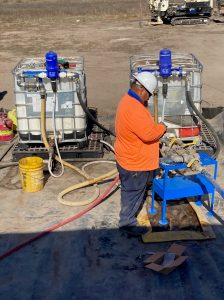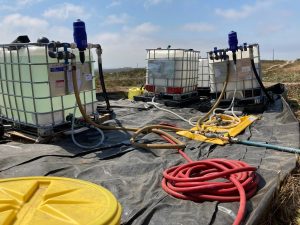Gregg Drilling cleans up groundwater with new injection technology
At Vandenberg Air Force base in 2019, Air Force staff and partners were focused on cleansing groundwater that had been polluted with chlorinated hydrocarbons, runoff from solvents that were used to spray down missile engines prior to launch. But the challenge was bigger than toxins in the water. Threatened vernal pool fairy shrimp, red-legged frogs and other endemic species in a nearby stream had to be protected from both the pollutants and their treatment.

Vandenberg encompasses 42 miles of some of the most pristine central California coastline and habitat types, including coastal dunes, wetlands and freshwater marshes. The nearly 100,000-acre base, located 160 miles northwest of Los Angeles, provides habitat for 18 federally threatened or endangered species. The military base has been applauded for its dedication to restoring and enhancing its natural environment.
Leaders of the base’s groundwater cleanup project knew that typical remediation techniques, such as excavating contaminated soil with heavy equipment, would have wreaked havoc on the fragile ecosystems many of the species call home on the base’s lands.
Gregg Drilling stepped in with a cleanup option that is safer, better for the environment and ultimately less expensive than more traditional approaches.
With the injection technology that Gregg Drilling used, contaminants are treated in place. Nothing comes out of the ground, and – unlike excavation – treatment doesn’t result in tons of contaminated waste that needs to be hauled many miles to landfills.
“Even if you didn’t care about the environment, it would be wasteful to excavate in a situation like Vandenberg’s,” says Jake Wilson, manager of remediation services for Gregg Drilling in northern California. “Imagine a semi-truck driving a football field’s worth of contaminated waste five hours to the landfill and back. With injection, nothing goes to a landfill. Soil remains in place, which is probably the best thing for it.”
Like poking needles into the ground

As its name implies, the injection treatment is a lot like poking needles into the ground to pump in fluid. Those “needles” are rods that are 1.5 inches in diameter, with perforated ends. The fluid they inject can be a chemical solution meant to create a reaction that breaks toxic compounds down into non-toxic ones. Or it can be carrying microbes that literally eat the contaminants.
Pollution in groundwater can come from a variety of activities, says Rob Bordenave, director of business development for Sealaska in California.
“The issue can be dry-cleaning chemicals, solvents, hydrocarbons, nitrates, chemicals used in firefighting – anything that leaches into groundwater,” he says. “We can inject products that treat all of those.”
The goal is to saturate soil and water beneath the surface with the right solution to eliminate unhealthy chemicals in the groundwater. Once that’s done, the small injection holes are permanently filled with cement from the bottom up to ensure they don’t become pathways for new pollutants. Some solutions can work very fast – the same day or week of treatment. Others take years. Water sampling and monitoring after the treatment helps reveal how well, and how fast, it’s working.
Whether fast or slow, addressing toxic chemicals in groundwater is essential, Bordenave says.
“Water continues to be incredibly valuable, and it’s becoming a more rare resource in the West,” he says. “Getting messes cleaned up to ensure there’s no intrusion into aquifers and water sources is important.”
The work is complex and interesting – especially for people who love to be outdoors, Wilson says.
“I really enjoy solving the problems,” he says. “It’s as if you were watching a scene in a play, but the curtains were closed and all you could do was poke holes in them to see what’s going on. That’s basically what we’re doing.”
What goes on under the surface is different in every situation, Wilson says, sometimes including underground streams or other dynamics that can influence treatment options.
Injection is relatively new, he says, and is disrupting more expensive and infrastructure-heavy alternatives. It’s a developing industry, and Sealaska, through Gregg Drilling, is among just a few companies doing it at scale. With relatively modest gear that’s easy to transport, it’s an approach that makes great sense in remote areas where removing vast quantities of soil would be difficult and expensive.
“Gregg Drilling is small enough to be nimble and quickly evolve as technologies and practices change, and also large enough to have the capital and resources to execute effectively,” says Alex Jernigan, remediation project manager at Gregg.
That positions the company well to lead with emerging solutions.
“There seems to have been a major shift in the past five years, moving from less environmentally friendly techniques toward better solutions like this one,” Bordenave says. “The industry is nowhere near where it’s going to be in 20 years.”
The possibilities for growth of this work are significant, he says. California is on the leading edge, but expansion to other areas is inevitable. Preserving natural resources is crucial everywhere.
“Water is an essential resource, which makes cleaning up groundwater in a sustainable manner more and more valuable,” Wilson says. “When we’re done, it looks like we weren’t ever there. There’s no long-term impact to anything on the surface.”
Gregg Drilling is getting more active in “green” remediation with a sponsorship of SURF – Sustainable Remediation Forum. Jernigan is Gregg’s SURF ambassador.
“The goal of the partnership is to get more involved in the environmental community,” Jernigan says. “We believe being involved with SURF will help keep Gregg in touch with the industry and help ensure we are moving forward in a way that benefits our customers and our environment.”
Success at Vandenburg AFB
For the project at Vandenburg, protecting the endangered frogs and shrimp required placing netting around the injection site and using minimal pressure when pumping in the fluid. If the injected fluid had pushed all the way to the nearby stream, it could have quickly upset the stream’s chemical balance.
The Gregg team had to renovate their rig to enable injecting 20 points at a time in order to make rapid progress at low pressure. To ensure accuracy and precision, the team used an inline mixing system that used mechanical devices to deliver the dosage of two separate chemicals at different mixing concentrations.
“Gregg’s inline system not only increased accuracy and precision in the field, but also efficiency as the team was able to inject more than 16,000 gallons of solution into the subsurface in a day,” Jernigan says. “The goal of our remediation systems is to be able to apply the science as the work plan was designed, while also doing the work in a proficient manner that reduces overall time on site needed compared to other forms of remediation.”
The team’s efforts paid off, as both the wildlife and the groundwater were saved.
“My long-term hope is that it makes more sense to remediate in place than to dig contamination out,” Wilson says. “There’s no way you dig it out and not wreak havoc on the stream population. Injection is a superior approach.”
“We haven’t really touched the full scale of what we can do.”




 Back to Stories
Back to Stories



 Previous
Previous